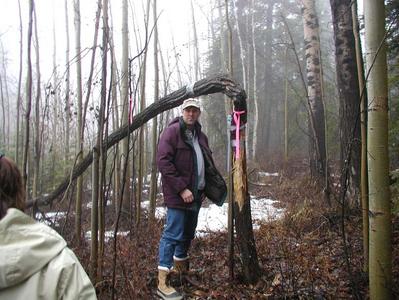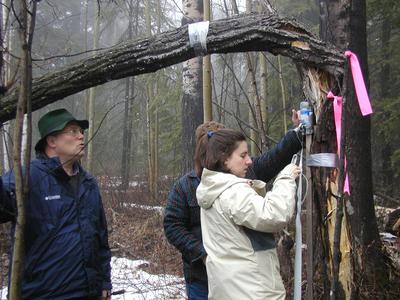30 April, 2002
Before I write anything else I have to say Happy Anniversary to my lovely
wife. I promise a very nice dinner celebration when I get home!
The Journal
Finally, I arrived in Fairbanks at 6pm local time. I arrived to very overcast
skies, light rain and temperatures in the upper 40's. In fact it wasn't
really all that different from the weather when I left Cincinnati.
After Dr. Jack Duman and Valerie Bennett of the University of Notre Dame met
me at the baggage claim area, we loaded up a Ford Expedition and headed back
to the home of Dr. Brian Barnes. Brian lives just a few miles outside of
Fairbanks, but looking outside would lead you to believe that his home is in
the middle of a forest. The house is surrounded by spruce trees still dark in
their evergreen color and birch and poplar still leafless and dormant. I have
not seen any deciduous trees or plants that have begun to show leaves for the
spring. Perhaps the plants know best considering the weather reports. The
weather service tells us that today will be damp with 7-8 inches of snow this
evening and turning much colder.
Even just the few miles outside of Fairbanks, Brian is without many of the
amenities at his home that we in Cincinnati take for granted. There is no
city water, no sewer system and no trash collection. Water is supplied
through wells and trucked in when necessary. Trash must be hauled out
individually and Brian's family composts everything possible. Sewage
treatment is handled on site as well.
Sleeping was an interesting situation. Even through I was very tired from the
traveling, I found it very difficult to go sleep while it was still light
outside. The official word is that it gets dark about 10:30pm right now and
gets light again at about 5am. The truth though is that it is still fairly
light at midnight and begins to lighten up again already by 4am.
When we woke up this morning, we found out that the road to the research site
at Toolik Lake is closed due to heavy snow. Not to let the news deter us from
our goal of insect collection however, we set out to find insects in the
hills and mountains of Fairbanks area. We started near a couple of sites
where temperature data collection devices had been placed. These devices
record temperatures in locations that have been identified as good beetle
habitat. The beetles and centipedes we are looking for tend to be found under
the bark of fallen logs and snags. To all of my AP Environmental students,
what was the definition of a snag? I'll remind you in my journal entry
tomorrow.
The good news of the day was that we were very successful in our collection
efforts. We found a number of beetle larvae, a few adult beetles and
centipedes everywhere we looked. Tomorrow, we will test the cold tolerance of
our sample specimens in Brian's lab at the university here.

I was the lucky winner in finding one of the data loggers

This is the adult of the beetle species we are looking for. They winter under the bark of dead Poplar trees.

Dr. Jack Duman and Valerie Bennett are downloading data from a temperature data logger.
Contact the TEA in the field at
.
If you cannot connect through your browser, copy the
TEA's e-mail address in the "To:" line of
your favorite e-mail package.
|
